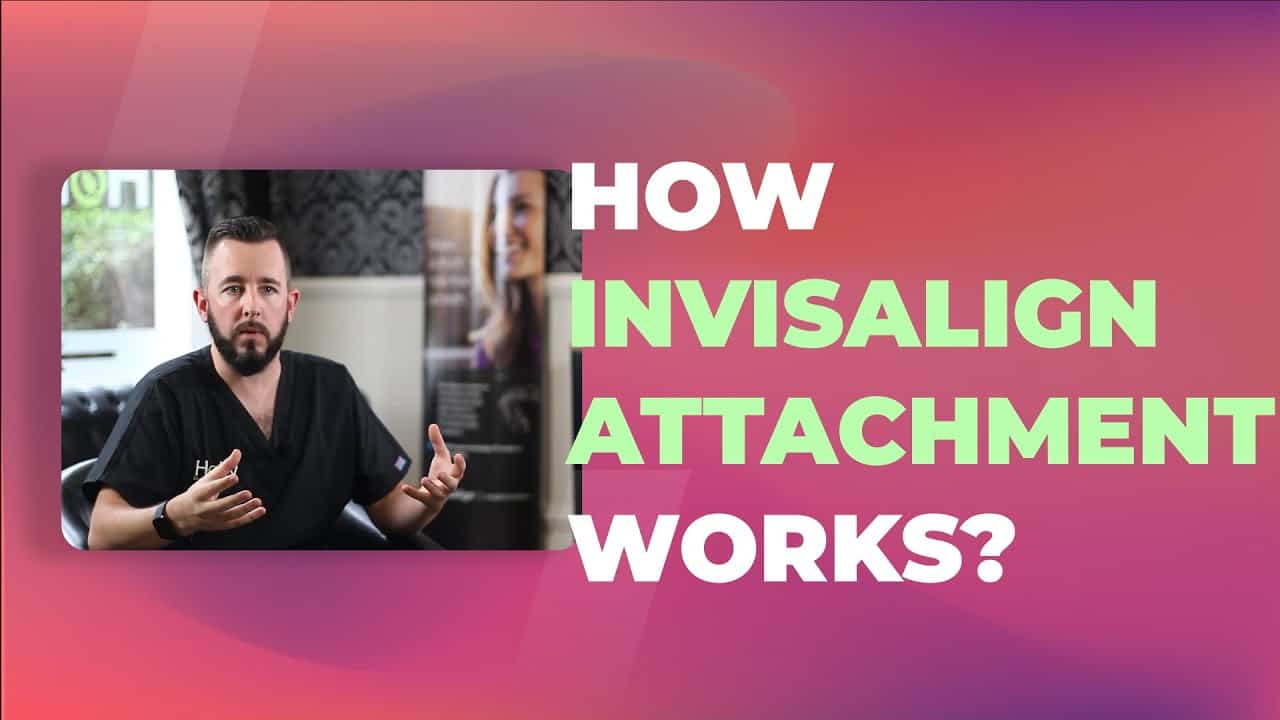
How do Invisalign attachments work?
What Are Invisalign Attachments?
Invisalign attachments are essentially the tooth-coloured, custom-designed replacements for what are essentially the metal square brackets in the fixed brace systems out there in Blackburn and Preston.
There’s a comparison between the two, but the fundamentals of how both systems work, rely on the same thing. But the way that the Invisalign system works better, and particularly the attachments work better, first of all, their tooth-coloured and discreet.
You can get tooth coloured brackets too, but the tooth coloured brackets are big square brackets on the front of every single tooth.
Attachment Alternatives
There are braces that you can then have the incognito braces. You can have them on the inside, but then they’re interfering with your tongue. Again, they’re on every single… they’re a nightmare to clean around, whereas, the Invisalign attachments are essentially custom-designed for each individual tooth. And that for a provider like me, for instance, that gives me an ample opportunity to be able to design the attachments and make them as invisible as possible, depending on what tooth they’re being attached to.
I can also be a little bit crafty. I’ve got instances where we need to make a specific movement on a tooth, but that movement doesn’t come until halfway through. And so, what I can do is I can minimise the number of attachments, have half the attachments on the first half of the treatment, switch things up halfway through, and again, only have half the attachment that’s then say for the instance on the front teeth, therefore making it again, it’s far superior to have an… literally a bracket on every single tooth throughout the entire duration of your treatment.
Different Shapes and Sizes
But specifically, Invisalign attachments, the way they work, can be a number of different shape sizes. You can get circular types – a lot of patients refer to them as buttons, you can get circular types, squares, rectangles, triangles, even combinations, precision attachments, or combinations of two much smaller attachments.
Essentially what they provide is, they provide a flat surface. And whether that flat surface is on towards the tip of the tooth, towards the gum line of the tooth, or again, where you’re going on a combination of two attachments, they could be working against each other. But essentially the whole point is that the aligner alone, cannot pull down on a tooth because a tooth has a very flat surface.
The aligner has a very flat surface. So essentially, the attachment and the flat surface on the attachment provide that extra little bit of grip for the brace system to actually push against in order to whether it be twisting the tooth, or turning the tooth.
Similar to Cogs
Now, I’ll very often use the analogy when trying to explain this to patients. Imagine cogs within a clock, they have teeth and the cogs have teeth because they need those two circular things to be able to grip against and work against each other. Without that, they just kind of keep smooth and just they’re going to rub smoothly against each other.
Whereas imagine then if that clock was turning extremely slowly and each of those two elements had at least one tooth, and that’s essentially what the attachment is. The attachment is that one tooth moves that cog very, very slowly.
In that particular situation, the cog is of course the tooth. So it’s only moving if the cog is rotating. It could be if it’s pulling that down, but that very slow movement is basically what is enabled by the flat surface on the attachment itself.
How Many Attachments Are Needed?
The number of attachments, type of attachments, the shape of the attachments and the position of the attachments is completely customised.
It’s completely tailor-made to the specific malocclusion. It could be crowding, it could be spacing, it could be that the jaws aren’t quite lined up properly. So, without seeing you for a consultation, nobody, no provider could sit there and say, “Okay, well, you’ll need.”
They can’t tell you from a photograph. They can’t tell you that you’ll need four attachments or you need six attachments. The average really for a normal Invisalign case, would be, I would say somewhere between about eight to 12 attachments.
Now, whether they’re on the back teeth, or whether they’re on the front teeth, you will always need some anchorage. Whether you’re pulling teeth, you’re pushing teeth, you twisting teeth; you’re always going to need some anchorage towards the back.
When I provide Invisalign treatment, I would always try and keep the attachments, where possible, as far back. It’s very, very rare that we would ever tend to have anything on say the front eight teeth, so that’s the four top and the four bottom.
But in order to answer that question, you would literally have to come in for a consultation. We’d assess everything to do with your bite (malocclusion), and the positions of the teeth, and work out what rotations work and what your end goals are as well.
Importance of a Consultation
Patients might come to see me and say, “I don’t like this little gap at the front.” “I don’t like the space in between my bottom teeth.” “I’m happy with my top teeth, but I’m not happy with my bottom teeth. Teeth are crowded.”
The whole point of consultation with us is that I will look at all your concerns and I will always prioritise your concerns. But in order to treat you the most effective with the Invisalign system, because there’s so much flexibility within it, I would always look at what else can we do?
A lot of the time we’ll broaden smiles and patients kind of sit there and go, “Oh yeah, I see a little bit more of the back teeth when I’m smiling”. We could say from a photograph without actually knowing what your concerns are, “you might need about five or six attachments.”
But the whole point is, you wouldn’t go to a decorator and say, “Okay, I want you to make my room perfect, but you can only use one tin of paint.” What you’d actually say to him is, “You use as much paint as you need to do to get the right end result.” And that’s what I would say with attachments; use the right number of attachments to get the right end result. It’s temporary. The attachments come off as soon as we finish the treatment.
Are They Visible?
Every single time I put attachments on, I’ll say to the patient, as I’m doing it, I promise you, these things don’t look as obvious as they feel because your mouth’s an extremely sensitive part of your body. You put these in, they are – they’re tiny. You know you got a couple of millimetres, these little white dots on the teeth.
Read our Guide on Getting Started With Invisalign for the people of Preston and Blackburn for more information on what to expect.
But to your mouth, it will feel obvious. God forbid if you’ve ever lost a tooth, if you’ve ever lost a filling, you’ve ever broadened a tooth or something like that, it will feel massive. It will feel massive to your tongue until such time where your brain just kind of accommodates it and gets used to it.
Again, I use a similar analogy with glasses wearers, you’ll switch from a frameless set of glasses; you’ll change that then to a set of glasses with a fairly thick frame. You put them on, you finally got your own lenses in the opticians. And all you see is you see these big rings.
You see these big marks, whether it be black or a dark look, you see these big rings around your eyes, but your brain just deletes it. Your brain gets used to it being there all the time. Eyelashes, nose, when you talk to somebody, you’re not looking at your nose, even though it’s right out in front of you because your brain deletes it.
And as much as patients get sort of worked up about maybe having these attachments, having them on the front teeth, your brain literally deletes it to the point where you come to the end of the treatment, I polish them off, and patients kind of go, “Oh, that feels weird.”
It will actually feel weird to have the attachments off. I can’t say how many attachments there will be for you, it is one of the biggest hangups about the Invisalign systems. But again, the alternative is the fixed brackets on every single tooth.
The attachments are usually not even on for the entire duration of the treatment in some aspects. It depends… I’d say they’re on for about 80 to 90% of the duration, but again, in the same way that the number of attachments is different for every patient, the number of aligners are different for every patient. The timeline and how long these things are going to take are different for every attachment.
What’s The Next Step?
So come in and have a consultation. We’ll always try and nail those things as close as we possibly can to give you an idea of timescales, whether it’s a number of attachments, whether we need to make any little spaces or anything like that, to get the teeth moving.
Contact our team on 01772 561748 or why not fill on our website form to get one of our friendly team to get back in touch with you.


